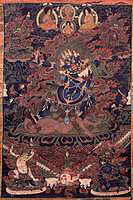
|
Tutelary Deity Yamantaka (painting no. 159)
|

View Larger Image |
||||||||||||||
|
The Inner Yama Dharmaraja, (Tibetan: Shin je Cho gyal Nangwa. Eng.: The Lord of Death, King of the Law). Yama, blue in colour, with one face and two hands holds a curved knife out to the right side and with the left hand holds a blood filled skullcup to heart. Fearsome and wrathful, having the appearance of a raksha daemon, his dark yellow hair flows upward flame like, rising above a black half vajra and the golden crown marked with five dry skulls. Wearing a green scarf and jewels, gold and bone ornaments he is adorned with a necklace of severed heads and wears a tiger skin around the waist tied with a green sash. Standing with the left leg bent and the right extended above a brown corpse, sun disc and lotus blossom above a black triangle mandala filled with blood he dwells completely surrounded within the red flames of pristine awareness. In front, three skullcups are arranged with torma (stylized food) and fearsome offerings. The background has the appearance of a charnel ground with wild animals, a corpse, two caityas (reliquary mounds) and two dark skinned Indian yogis. At the lower left is white Peaceful Yamaraja with two hands, holding a damaru drum and a divination arrow with the left. Above that is green Increasing Yamaraja holding a sword and banner. To the right is red Powerful Yamaraja holding a wishing jewel and a skullcup to the heart. Below that is blue-black Wrathful Yamaraja holding a bone stick and a lasso, embraced by the consort Chamundi, black in colour, offering a skullcup to the Lord. Each of the Yamas has a buffalo head, adorned with various wrathful ornaments and stands upon a buffalo of similar colour, above a corpse, sun disc and lotus surrounded by the flames of pristine awareness. At the top center is the bodhisattva of wisdom, Manjushri, orange holding a sword and lotus supporting a book. To the left is the mahasiddha Lalitavajra, dark skinned, wearing monastic robes and a red pandita hat. (A praise to a lama is written in fine gold lettering beneath this figure). To the left is a lama wearing monastic robes and a yellow pandita hat. With the hands folded in the Dharma Teaching mudra (gesture) grasping the stem of a lotus blossom supporting a sword and book - this is probably the Lord Tsongkhapa (1357-1419). Below Manjushri and seated in a rainbow sphere is lama wearing monastic robes and a pandita hat, displaying the gesture of giving blessing with the right hand and holding a book with the left. "In the special, noble, Vajra Vehicle, among the numerous four tantras [kriya, carya, yoga and anuttara] this protector is of the Anuttarayoga. Of those, from the three [classes], Method, Wisdom and Non-dual, this is Method Tantra. From the three famous Father Tantras of the Yamari Cycle, Rakta [Red], Krishna [Black], and Bhairava [Terrifying], this is the uncommon protector of the Vajra Bhairava." (Ngor Ponlop Ngawang Legdrup, 19th century). From the three levels of practice of the Yama Dharmaraja, outer, inner and secret, this is the Inner, wisdom deity, protector practice special to the Gelugpa School. Although similar in appearance and name Yama, the 'Lord of Death,' shown as the central figure in Buddhist depictions of the Hell Realms and this Yama Dharmaraja are not the same individual. The first is conceived of as a sentient creature and the King of the Pretas (ghosts) and arises from the Abhidharma literature based on a Theravadin and Sutrayana model of the world. The second is based exclusively on the Bhairava Root Tantra where Manjushri assumes a variety of terrifying (bhairava) forms to subdue Yama (death, a synonym for the endless suffering of cyclic existence) and uses the theme of death as a metaphor for an entire cycle of tantric practice. The words Yama, Yamantaka and Bhairava appear frequently in all classes of tantra as attendant deities, protectors or as worldly gods beneath the feet of Tutelary Deities (ishtadevata) such as Vajra Yogini and in this instance represent the various negative emotions to be conquered through meditation. It is therefore important not to confuse the various models and to understand each in its own place. The painting style is central Tibetan and the technique is called ‘black scroll’ (nag thang) executed on a black background with a generous use of gold and rich earth pigments. J.Watt 8-98
|
|||||||||||||||
Photographed Image Copyright © 1998 Shelley & Donald Rubin Foundation
|
|
| |
Next Image |